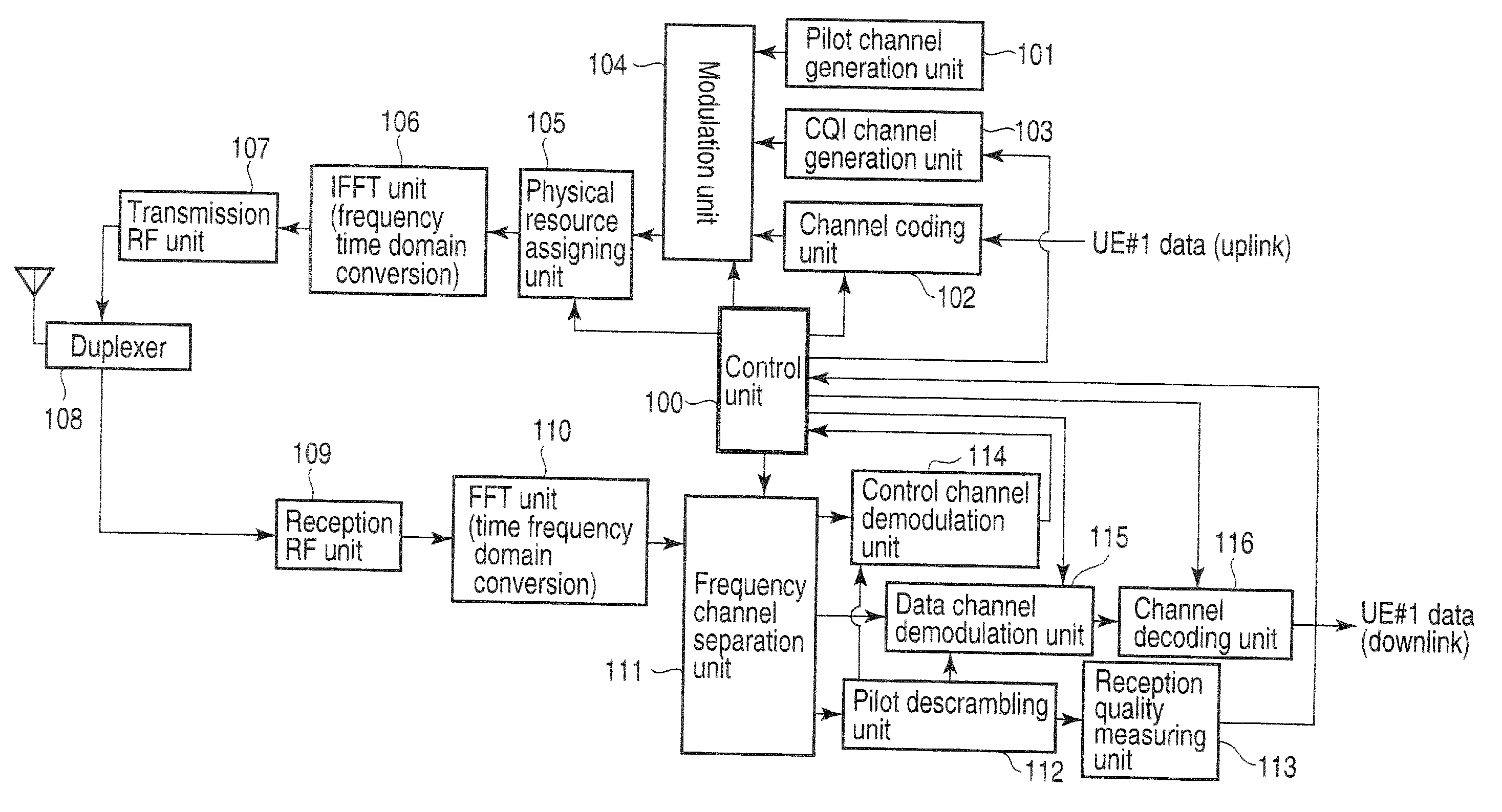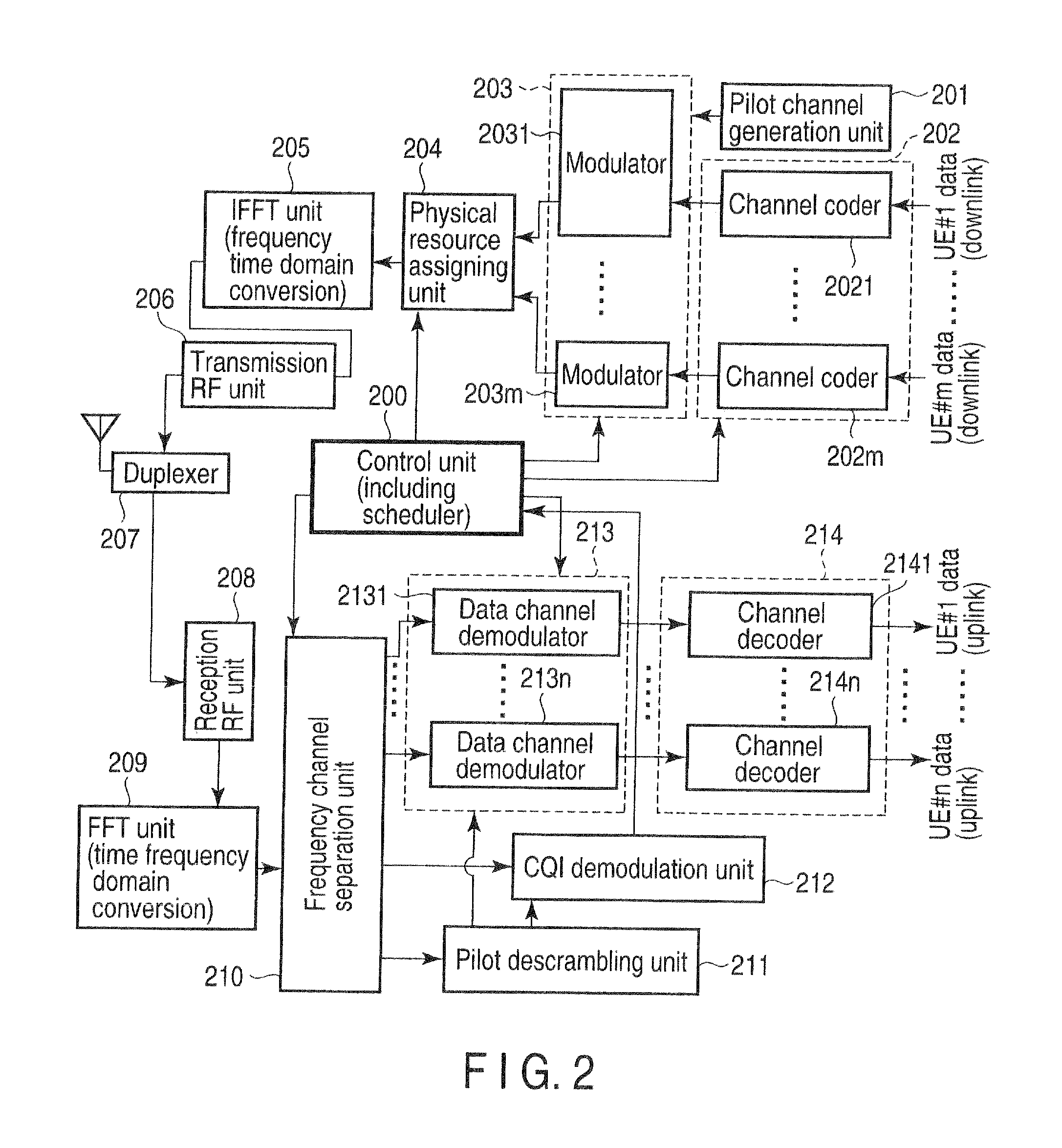Wireless base station apparatus and mobile wireless terminal apparatus
a technology of mobile wireless terminals and base stations, applied in electrical devices, wireless commuication services, transmission path sub-channel allocation, etc., can solve problems such as difficulty in effectively using bandwidths, and achieve the effect of effectively using bandwidths and preventing any degradation of reception characteristics
- Summary
- Abstract
- Description
- Claims
- Application Information
AI Technical Summary
Benefits of technology
Problems solved by technology
Method used
Image
Examples
example 1
[0069]In Example 1, an OFDM cellular system will be exemplified which operates, in a single 100-MHz frequency band, a mobile wireless terminal apparatus A capable of receiving a maximum channel bandwidth of 20 MHz and a mobile wireless terminal apparatus B capable of receiving a channel bandwidth of 100 MHz.
[0070]The mobile wireless terminal apparatus A can receive a channel band as shown in FIG. 3. More specifically, 100 RBs (resource blocks) each including 12 subcarriers at a subcarrier spacing of 15 kHz and having a bandwidth of 180 kHz are arranged in one transmission signal having a channel bandwidth of 20 MHz transmitted from the wireless base station apparatus. A DC subcarrier is arranged at the center frequency, thereby forming a transmission signal band of 18.015 MHz (the number of subcarriers=1201). Note that the DC subcarrier is not transmitted.
[0071]The difference between the channel bandwidth of 20 MHz and the transmission signal band of 18.015 MHz, i.e., 1.985 MHz (0.9...
example 2
[0081]In Example 2, an OFDM cellular system will be exemplified which operates, in a single 60-MHz frequency band, a mobile wireless terminal apparatus A capable of receiving a maximum channel bandwidth of 20 MHz and a mobile wireless terminal apparatus B capable of receiving a channel bandwidth of 60 MHz.
[0082]The mobile wireless terminal apparatus A can receive a channel band as shown in FIG. 6. More specifically, 1,200 subcarriers at a subcarrier spacing of 15 kHz are arranged in one transmission signal having a channel bandwidth of 20 MHz transmitted from the wireless base station apparatus. A DC subcarrier is arranged at the center frequency, thereby forming a transmission signal band of 18.015 MHz (the number of subcarriers=1201). Note that the DC subcarrier is not transmitted.
[0083]The difference between the channel bandwidth of 20 MHz and the transmission signal band of 18.015 MHz, i.e., 1.985 MHz (0.9925 MHz on each side) serves as a guard band. About 5% of the 20-MHz chann...
example 3
[0113]In Example 3, an OFDM cellular system will be exemplified which operates, in a single 100-MHz frequency band, a mobile wireless terminal apparatus A capable of receiving a maximum channel bandwidth of 20 MHz and a mobile wireless terminal apparatus B capable of receiving a channel bandwidth of 100 MHz.
[0114]The mobile wireless terminal apparatus A can receive a channel band as shown in FIG. 6. More specifically, 1,200 subcarriers at a subcarrier spacing of 15 kHz are arranged in one transmission signal having a channel bandwidth of 20 MHz transmitted from the wireless base station apparatus. A DC subcarrier is arranged at the center frequency, thereby forming a transmission signal band of 18.015 MHz (the number of subcarriers=1201). Note that the DC subcarrier is not transmitted.
[0115]The difference between the channel bandwidth of 20 MHz and the transmission signal band of 18.015 MHz, i.e., 1.985 MHz (0.9925 MHz on each side) serves as a guard band. About 5% of the 20-MHz cha...
PUM
 Login to View More
Login to View More Abstract
Description
Claims
Application Information
 Login to View More
Login to View More - R&D
- Intellectual Property
- Life Sciences
- Materials
- Tech Scout
- Unparalleled Data Quality
- Higher Quality Content
- 60% Fewer Hallucinations
Browse by: Latest US Patents, China's latest patents, Technical Efficacy Thesaurus, Application Domain, Technology Topic, Popular Technical Reports.
© 2025 PatSnap. All rights reserved.Legal|Privacy policy|Modern Slavery Act Transparency Statement|Sitemap|About US| Contact US: help@patsnap.com



